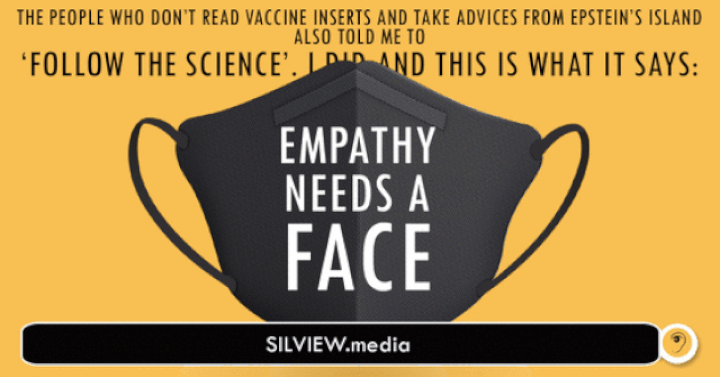Empathy and social intelligence may have played a more important role in human evolution than any other type of intelligence or instincts. Much of what we’ve achieved in millennia has been eroded over the span of the past 2-3 decades, and especially in Covidiocracy.
Chapter One: “WE ARE HARDWIRED TO BE KIND”
“Human nature is often portrayed as selfish and power hungry, but research by Dacher Keltner finds that we are hard-wired to be kind.” – University of California
Chapter Two: “the neurons that shaped civilisation”

A neuroscientist from UC San Deigo, V.S. Ramachandran, recently spoke with the Greater Good Science Center about the relationship between empathy and mirror neurons. “the neurons that shaped civilisation”:
“For example, pretend somebody pokes my left thumb with a needle. We know that the insular cortex fires cells and we experience a painful sensation. The agony of pain is probably experienced in a region called the anterior cingulate, where there are cells that respond to pain. The next stage in pain processing, we experience the agony, the painfulness, the affective quality of pain.
It turns out these anterior cingulate neurons that respond to my thumb being poked will also fire when I watch you being poked—but only a subset of them. There are non-mirror neuron pain neurons and there are mirror neuron pain neurons.
So these [mirror] neurons are probably involved in empathy for pain. If I really and truly empathize with your pain, I need to experience it myself. That’s what the mirror neurons are doing, allowing me to empathize with your pain—saying, in effect, that person is experiencing the same agony and excruciating pain as you would if somebody were to poke you with a needle directly. That’s the basis of all empathy.”
V.S. Ramachandran, UC San Deigo neuroscientist
In an interview for a Berkeley University magazine, the scientist makes an interesting note that we must remember for further reference:
Mirror neurons enable me to see you as an intentional being, with purpose and intention. In fact, we suggested nearly a decade ago that mirror neuron dysfunction may be involved in autism. People with autism, ironically sometimes they mimic constantly what you’re doing, but it’s also true that they’re bad at imitation and they don’t have empathy, they don’t have a theory of mind, they can’t infer your intentions, they don’t engage in pretend play. In pretend play, what I do is temporarily say, “I’m going to be this superhero,” so you do role play. That requires a theory of mind.
Neuroscientist V.S. Ramachandran
So take all the properties of mirror neurons, make a list of them, and list all the things that are going wrong in autism—there’s a very good match. Not every symptom, but many of the symptoms match beautifully. And it’s controversial: There are about seven papers claiming that it’s true, using brain imaging, and maybe one or two claiming that there’s no correlation [between mirror neurons and autism].
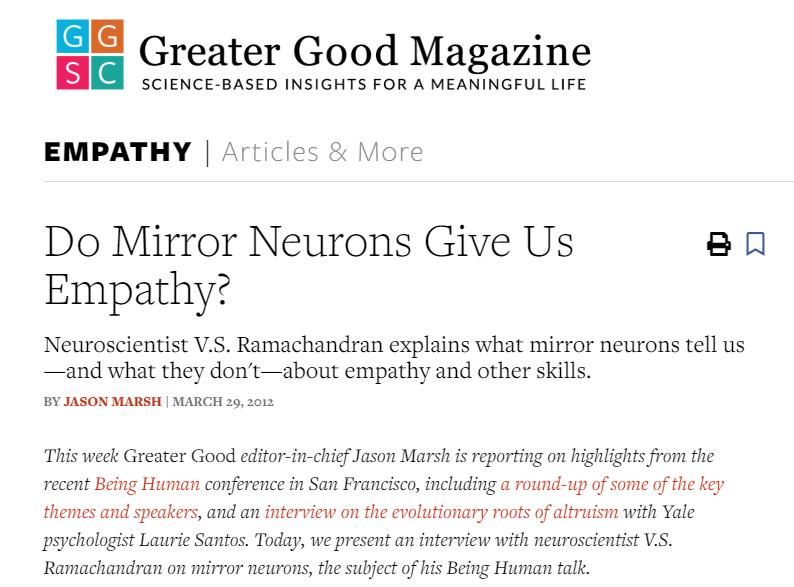
Chapter Three: “EMPATHY NEEDS A FACE”
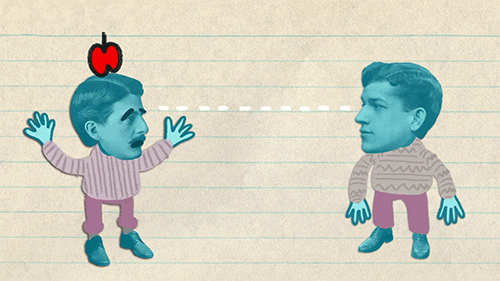
What connect the first two chapters into a “holy trinity” for neuroscience are faces.
In a study published by Journal of Consciousness Studies and titled “Empathy Needs a Face”, Jonathan Cole, psychologist at Bournemouth University, notes:
“The importance of the face is best understood, it is suggested, from the effects of visible facial difference in people. Their experience reflects the ways in which the face may be necessary for the interpersonal relatedness underlying such ‘sharing’ mind states as empathy. It is proposed that the face evolved as a result of several evolutionary pressures but that it is well placed to assume the role of an embodied representation of the increasingly refined inner states of mind that developed as primates became more social, and required more complex social intelligence. The consequences of various forms of facial disfigurement on interpersonal relatedness and intersubjectivity are then discussed. These narratives reveal the importance of the face in the development of the self-esteem that seems a prerequisite of being able to initiate, and enter, relationships between people. Such experiences are beyond normal experience and, as such, require an extended understanding of the other: to understand facial difference requires empathy. But, in addition, it is also suggested that empathy itself is supported by, and requires, the embodied expression and communication of emotion that the face provides.”
Another study, this time coming from Italian universities, cites:
“Prefrontal virtual perturbation may have induced a less empathic responsiveness toward the emotional faces, with significant effect on the attributional functions. The suggested interpretation of these results is supported by the fact that prefrontal area includes specific processing modules for emotional information processing, and it is able to integrate input from various sources, including motivation and representations from cognitive (such as ToM) and emotional (such as emotional expressions) networks. Thus, the role of dMPFC to empathy-related response was elucidated, with possible circular effect on both monitoring ability (cue detection) and empathy responsiveness (trait empathy).”
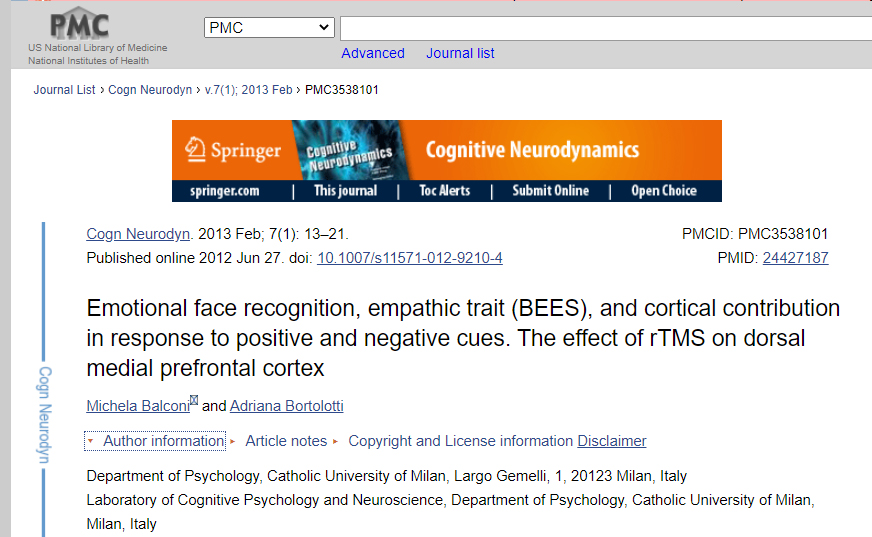
Now imagine being unable to recognize your own mother’s face. You may know your mother’ voice, her smell, her size, and shape, but her face means nothing to you.
This is face blindness, or prosopagnosia, a disorder that may be congenital or caused by brain injury. While it can occur in many people who are not autistic, it is quite common among people with autism.
Whether you call it prosopagnosia, facial agnosia, or face blindness, the disorder may be mild (inability to remember familiar faces) or severe (inability to recognize a face as being different from an object).
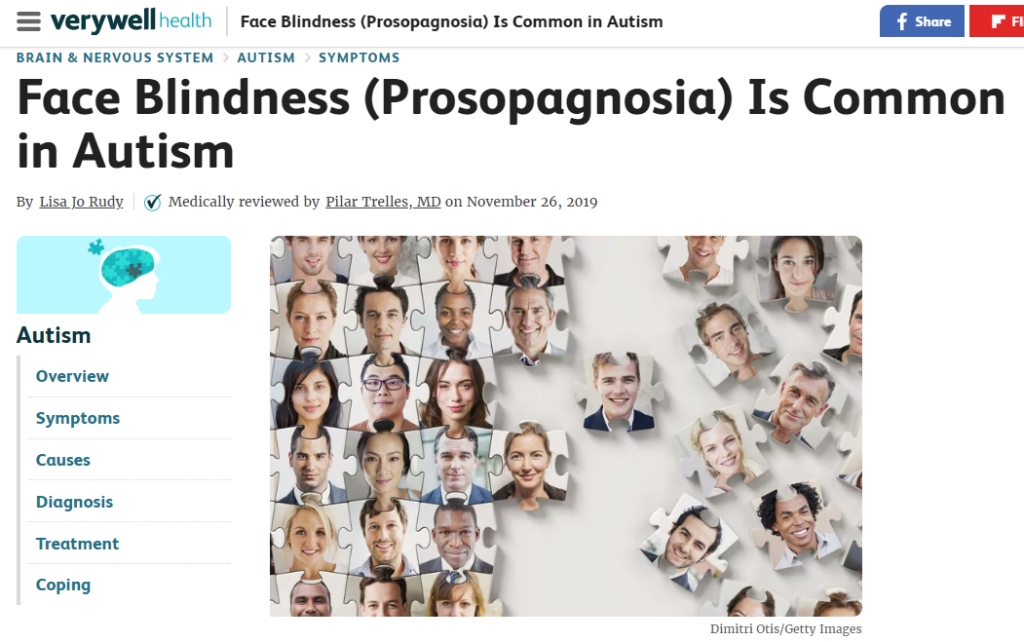
According to the National Institutes for Neurological Disorders and Stroke, “Prosopagnosia is not related to memory dysfunction, memory loss, impaired vision, or learning disabilities. Prosopagnosia is thought to be the result of abnormalities, damage, or impairment in the right fusiform gyrus, a fold in the brain that appears to coordinate the neural systems that control facial perception and memory. Congenital prosopagnosia appears to run in families, which makes it likely to be the result of a genetic mutation or deletion.” (Source)
While face blindness is not a “core symptom” of autism, it is not uncommon for autistic people. In some cases, face blindness may be at the root of the apparent lack of empathy or very real difficulties with non-verbal communication. How can you read a face when you can’t distinguish a face from an object, or recognize the person speaking to you?
While face blindness may be an issue for your loved one with autism, it is easy to confuse face blindness with typical autistic symptoms. For example, many children with autism fail to respond to non-verbal cues such as smiles, frowns, or other facial “language” – even though they are able to recognize the face they are looking at. Their lack of response may relate to social communication deficits rather than to prosopagnosia.
Can they recognize the face of a favorite character on television or a photograph of a relative with no auditory clues? If so, they are recognizing a face – and most likely are not suffering from face blindness.
There is no cure for face blindness. Children with face blindness can be taught some compensatory techniques such as listening for emotional meaning or using mnemonic devices to remember names without necessarily recognizing faces. Before beginning such training, however, it’s important to distinguish face-blindness from other autistic symptoms that can have similar appearances, such as difficulties with eye contact.
Other specialists argue that autists can be empathic, and by doing so they further accentuate the strong interdependence between empathy and facial recognition:
“Autism is associated with other emotional difficulties, such as recognizing another person’s emotions. Although this trait is almost universally accepted as being part of autism, there’s little scientific evidence to back up this notion.
In 2013, we tested the ability of people with alexithymia, autism, both conditions or neither to recognize emotions from facial expressions. Again, we found that alexithymia is associated with problems in emotion recognition, but autism is not5. In a 2012 study, researchers at Goldsmiths, University of London found exactly the same results when they tested emotion recognition using voices rather than faces6.
Recognizing an emotion in a face depends in part on information from the eyes and mouth. People with autism often avoid looking into other people’s eyes, which could contribute to their difficulty detecting emotions.
But again, we wanted to know: Which is driving gaze avoidance — autism or alexithymia? We showed movies to the same four groups described above and used eye-tracking technology to determine what each person was looking at in the movie.
We found that people with autism, whether with or without alexithymia, spend less time looking at faces than do people without autism. But when individuals who have autism but not alexithymia look at faces, they scan the eyes and mouth in a pattern similar to those without autism.
By contrast, people with alexithymia, regardless of their autism status, look at faces for a typical amount of time, but show altered patterns of scanning the eyes and mouth. This altered pattern might underlie their difficulties with emotion recognition” – Scientific American
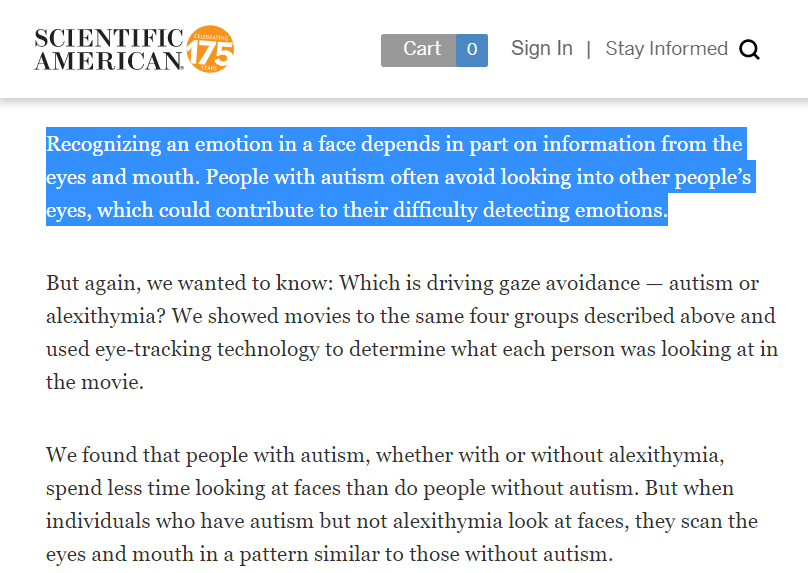
Face recognition differences may reflect processing or structural differences in the brain. For example, people with prosopagnosia may have reduced connectivity between brain regions in the face processing network.
Another idea is that face recognition ability is related to other more general cognitive abilities, like memory or visual processing. Here, though, findings are mixed. Some research supports a link between face recognition and specific abilities like visual processing. But other research has discounted this idea.
Yet another possibility is that individual differences in face recognition reflect a person’s personality or their social and emotional functioning. Interestingly, face recognition ability has been linked to measures of empathy and anxiety.

Empathy reflects a person’s ability to understand and share the feelings of another person. In 2010, researchers asked volunteers to try and remember the identity of a number of faces presented one at a time. They were later presented with the same faces mixed together with new faces and were asked to state whether each face was “old” (learnt) or “new”. The performance was measured by the number of learnt faces correctly identified as being familiar. The researchers found that those who rated themselves as high in empathy performed significantly better at a face recognition memory task than those with low empathy skills.
Research has also found that people who report significantly lower levels of general anxiety have better face recognition skills than those who are have higher anxiety.
Interestingly, more recent research has suggested the link between anxiety and face recognition ability may be more prominent for women, and may be particularly related to anxiety in social situations (social anxiety).
Situational anxiety may also play a role. For example, face recognition may be impaired when an eyewitness is asked to try and identify the face of a suspect viewed in a stressful situation.
Read more on hoe facial recognition impacts personality from Karen Lander, Senior Lecturer in Experimental Psychology, University of Manchester, who published a very interesting article on the topic in The Conversation.
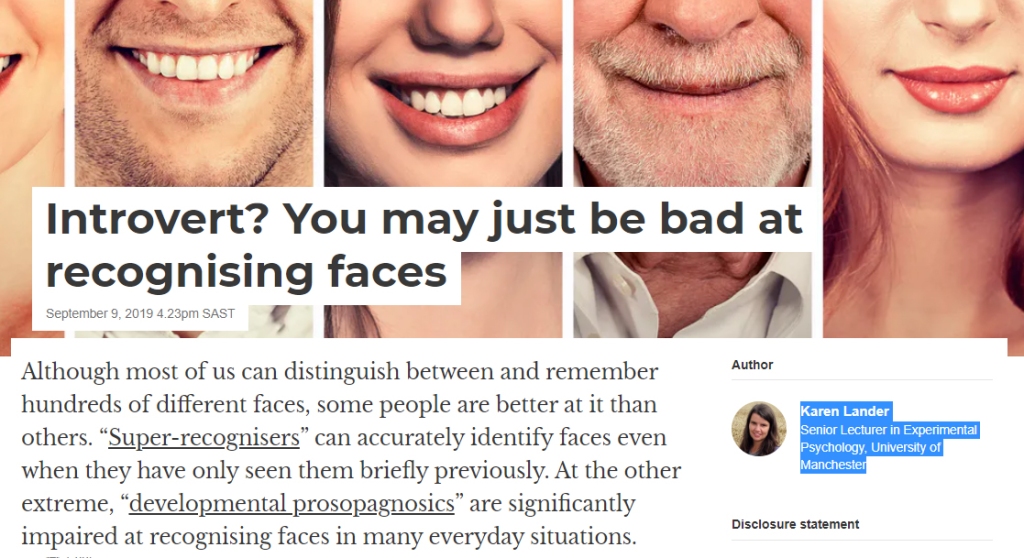
Everything above proves how much masks are robbing from us individually, but also from the very fabric of societal cohesion. This information is not new and not fringe, actually the attack on about empathy has been going on for ages and noted by many specialists and scholars, such as Psychology Today, eg.
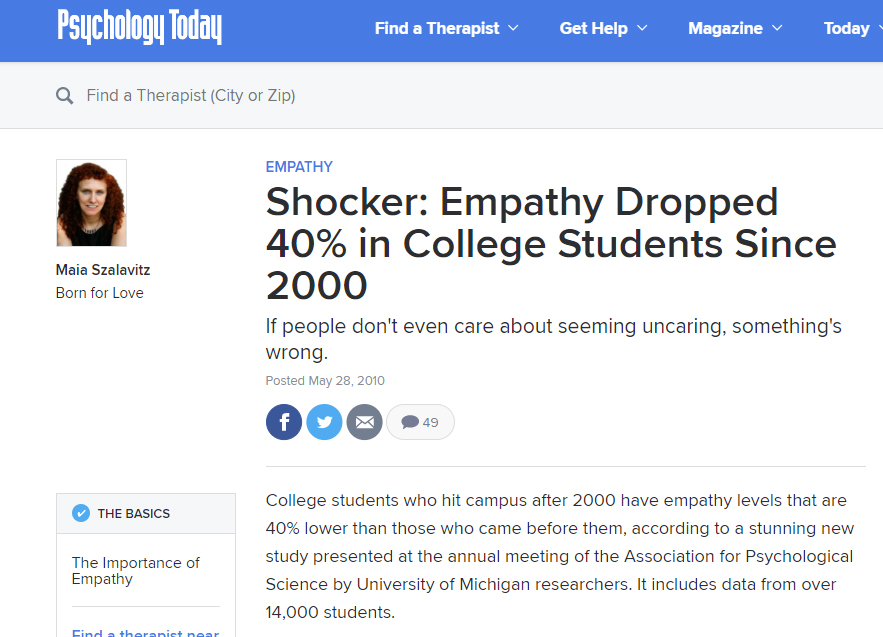
So the science we’ve presented here can’t be unknown to our decision-makers, it can only be wilfully ignored.
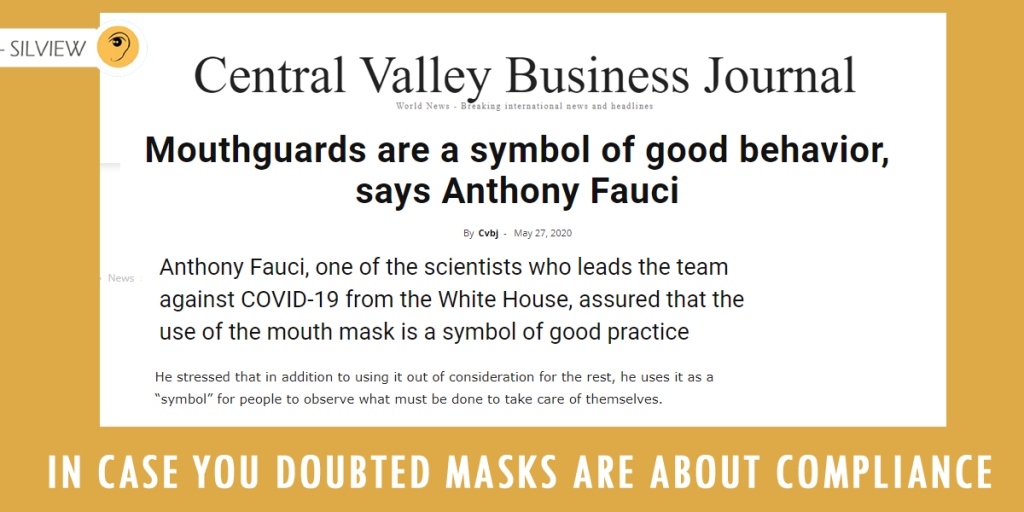
To be continued?
Our work and existence, as media and people, is funded solely by our most generous supporters. But we’re not really covering our costs so far, and we’re in dire needs to upgrade our equipment, especially for video production.
Help SILVIEW.media survive and grow, please donate here, anything helps. Thank you!
! Articles can always be subject of later editing as a way of perfecting them
